This post is part of a larger deep dive
Curious about the role of memory formation and retrieval in Memento? Check out Memento Explained!
Or read the full Memento article!
This post is part of a larger deep dive
Curious about the role of memory formation and retrieval in Memento? Check out Memento Explained!
Or read the full Memento article!
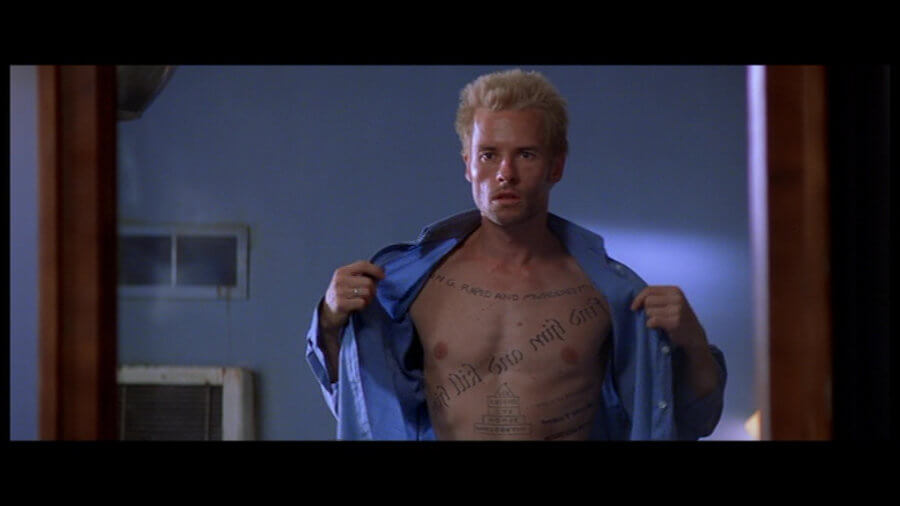
Memento is considered by many to be one of the most scientifically accurate movies with regards to the depiction of human amnesia. And for good reason.
If you read the section above about memory, you should be able to link some of the information I described with Leonard’s condition. Indeed, the memory impairment Leonard suffers appears to have been based patient H.M.’s condition as discussed above.
Many reviews and analysis I checked appear to suggest that Leonard has a short-term memory impairment. This is wrong. His short-term/working memory is just fine. As I explained in the section Short-term and working-memory, working memory deals with information at the short time scales (up to a few minutes if rehearsal takes place) and it’s what allows you to follow up conversations (which Leonard has no problem with).
Instead, Leonard’s memory issues come from the inability of his brain to transfer short-term memories to long-term memory storage sites (check out the section The 3 stages of memory if you haven’t done so). Information enters his brain, but never makes it to long-term memory; it stays in working memory for as long as he is able to hold it, but then it vanishes forever.
More specifically, it’s the transfer of newly-acquired episodic memories that is affected (see the section Explicit memory for more information). Hence, Leonard has anterograde amnesia. Because he can recollect events prior to the head trauma, he doesn’t exhibit retrograde amnesia (check out the section When memory fails: Anterograde and Retrograde amnesia).
I’ll start the analysis of Memento by describing the two interpretations that are the most obvious, and will also present the arguments that I believe corroborate either of them.
I’ll end the this analysis with an additional interpretation which, although rarely considered, is, in my opinion, a viable contender.


When you finish watching the movie, you will be probably wonder which of the two main interpretations is the correct one: what Leonard believes it happened on the one hand, and what Teddy reports to Leonard on the other.
In truth, I think Nolan’s idea was to leave sufficient ambiguity in the story such that either interpretation could be viewed as the correct one.
Here, I’ll detail both interpretations and why they both have points in favour and against them.
Just to recap the background story: Leonard Shelby was a claims insurance investigator, who enjoyed a promotion after he successfully solved the case of a certain Sammy Jankis who claimed to have anterograde amnesia. He lived a relatively peaceful life with his wife, Catherine, until, one night, two thugs break in the house where he ans his wife were living and rape Catherine in the bathroom. He wakes up and manages to shoot one of the assailants dead. However, he gets hit on the head by a second thug who had been hidden behind the door, and the head trauma rendered Leonard amnesiac. As a result, he cannot remember anything for longer than a few seconds.


According to Teddy, who describes this version of the events to Leonard close to the end of the film, Sammy Jankis was in fact a conman. He was faking his condition in order to get insurance money, but Leonard successfully exposed him and, for that reason, got a promotion.
In this version, Leonard’s wife was raped but survived the attack, although Leonard did become amnesiac as a result of the head injury.
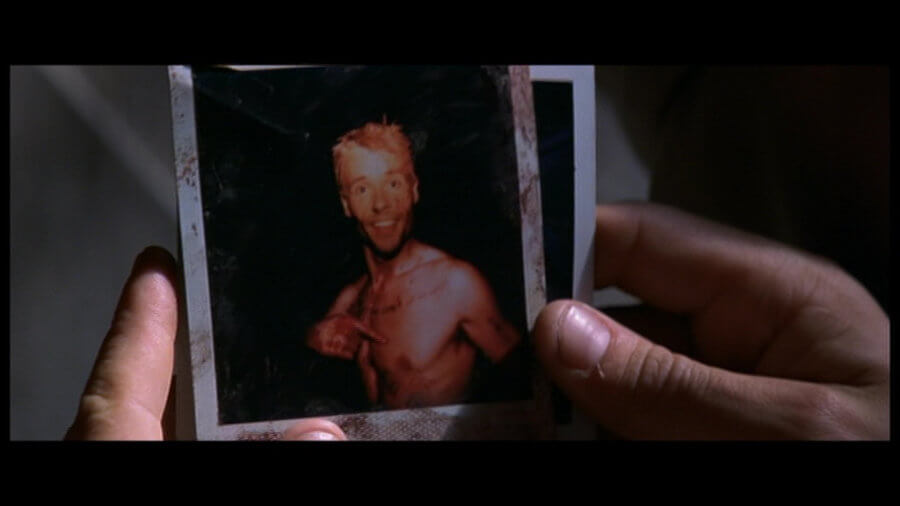
Teddy was the officer assigned to Leonard’s wife case. He felt compassionate about Leonard’s ordeal, so he helped Leonard find the second thug (a certain John G.) the previous year. When they found John G., Leonard killed him, and Teddy took a photo of Leonard smiling after the fact (this is the photograph where Leonard is smiling and covered in blood).
However, due to Leonard’s condition, he doesn’t remember having killed John G (Teddy says: “But when you killed him, I was so convinced that you’d remember. But it didn’t stick. Like nothing ever sticks”). Teddy is a corrupt cop, so he decides to make a profit off Leonard’s condition by “helping” him to track other John G.’s (probably all drug dealers) and murder them, in order to keep their money.
Presumably, Leonard had already come across evidence that John G. was already dead. This fact was probably met with anguish, because it meant there was nothing else to do, no wife to avenge, no sense of accomplishment and justice again. So Leonard decides to rip 12 crucial pages of the police report of his wife’s case (which Leonard received from Teddy), so that he could create a puzzle that would always remain unsolvable.
Finally, Teddy also mentions that it was Leonard’s wife who was diabetic (Sammy Jankis didn’t have a wife). Leonard just invented Sammy’s story because he couldn’t cope with the fact he had accidentally killed his wife, so he repressed this entire memory.
So Leonard is deceiting himself. Every time he realises that there is no John G. to track down anymore, he chooses to dismiss the evidence and concocts another chase for the only purpose of having a purpose in life.

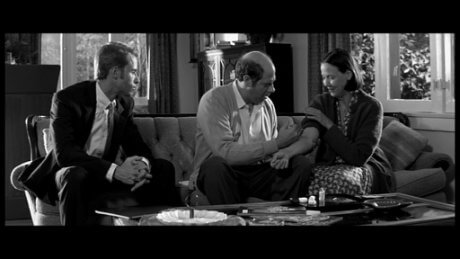
In this interpretation (which is Leonard’s view of the events), Sammy Jankis condition was real: he had indeed a car accident which caused his anterograde amnesia. He also had a wife, who, out of desperation for Sammy’s condition, asked him to administer insulin shots over and over again. When she died of an overdose, Sammy ended up in a nursing home. Although Leonard maintained he believed Sammy was truly amnesiac, he nonetheless ruled Sammy’s amnesia as psychological, not physical, and got promoted.
According to this interpretation, Leonard’s wife wasn’t diabetic. On the day of the attack, she was raped and murdered by the thugs. One of them hit Leonard and fled, leaving him with amnesia. Leonard has been looking for him ever since.
Leonard is an extremely unreliable narrator. That becomes evident towards the end of the film, when Leonard decides to frame Teddy simply because he disliked Teddy’s version of the events.
Check out these two thoughts of Leonard when he is about to frame Teddy:
– You think I just want another puzzle to solve? Another John G. to look for? You’re a John G. So you can be my John G.
– Do I lie to myself to be happy? In your case Teddy… yes, I will.
Leonard is pretty much admitting here that he’s going to frame Teddy even though he’s probably quite sure he isn’t the real John G.
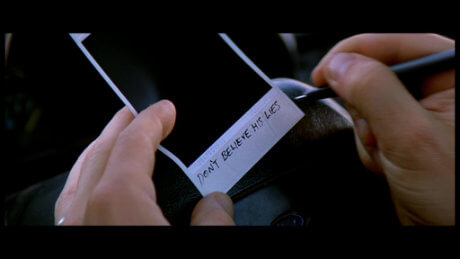
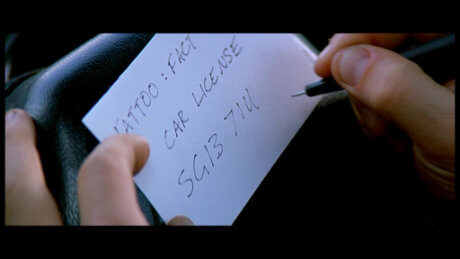
Moreover, instead of going straight to the point and write down that Teddy is his wife’s murderer, he decides to write “Do not trust his lies” on Teddy’s photo, along with his license plate, knowing perfectly well that these two clues will lead to making Teddy the next target.

What about the photos he burns (the photo of dead Jimmy and the photo of Leonard covered in blood and smilling)? Even if he did not believe Teddy, why would he burn those photos that may be clues to his wife’s case?
The only reasonable explanation for Leonard’s behaviour is that he does not want to come to the conclusion that Teddy is telling the truth. Burning those revelatory photos will ensure Leonard won’t investigate if John G. has already been killed.
Leonard even thinks: “Can I just let myself forget what you [Teddy] have told me?“
This entire scene really lends most of the proof that Leonard is playing detective and that he chooses to be incognizant about what trully happened with his wife and her attackers.


Furthermore, when Teddy begins to mention that it was Leonard’s wife who was diabetic, Leonard briefly recalls injecting the needle on her thigh, but then this memory is replaced by him pinching her instead. It could be that Leonard has been editing memories of his interactions with his wife, again suggesting he has been repressing every fact related to the fatal insulin shots.
In fact, during a conversion at the cafe earlier on in the film, Leonard discusses the problems of memory, not being an accurate storage of events as they happened.
Indeed, as discussed in the section The organization of memory, memories are very unreliable; vivid memories that we believe to be perfect mental records of events, will have actually suffered numerous changes throughout our lives.

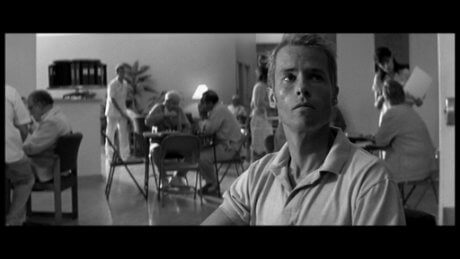
But clearly the strongest case for I1 is the almost subliminal change of scene when Sammy Jankis ends up in the nursing home. During the close-up, Sammy shortly becomes Leonard. This could be a subtle clue that the two characters are indeed one and the same: Leonard.
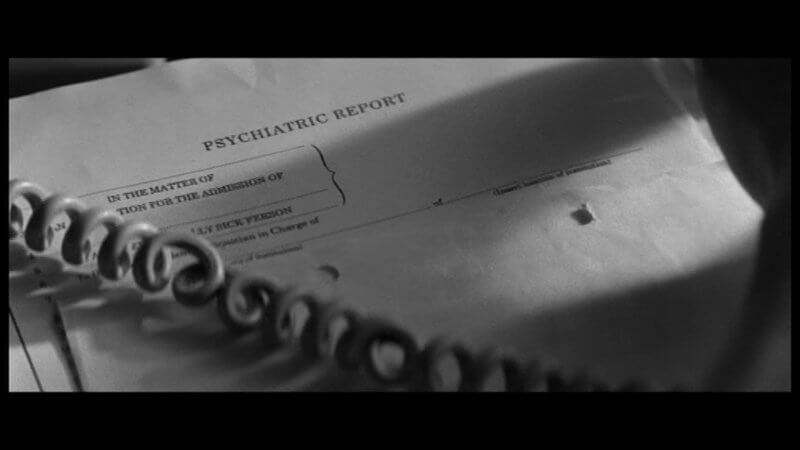
Finally, about 54 minutes into the film (during one of the grey scenes) Leonard gets hold of the police report of his wife’s case while talking to officer Gammel over the phone.
For a brief moment we see a document with the title “PSYCHIATRIC REPORT”. Note, that this brief of files were compiled by Leonard (even the police report, according to Teddy). Therefore, it’s not a stretch to think that Nolan included this psychiatric report among Leonard’s documents as a subtle clue that Leonard was at some point being treated by a psychiatrist – maybe during his stay at the nursing facility.
Teddy is a notorious liar. He lied he didn’t know Leonard, he lied Jimmy was John G., he lied he was a snitch, and so on. In sum, he lied pretty much the entire film. Is there any reason to believe that he is telling the truth about his version of Leonard’s story?
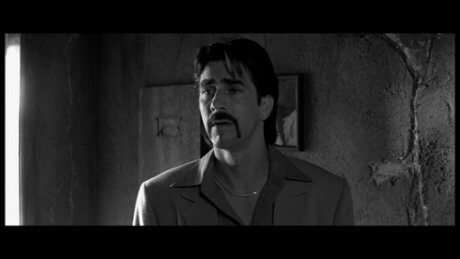

We could think that the story is just Teddy’s attempt to get out of a bad situation. Jimmy knew about Sammy Jankis, which made Leonard realise had he killed the wrong man. Teddy is suddenly confronted by a very angry and armed Leonard, and tries to get out of the situation by trying to manipulate Leonard’s memories into believing Sammy Jankis story is nonsense; that Leonard is the one with a diabetic wife, who he accidentally, but fatally, killed with insulin shots.
Let’s assume that I1 is correct: Sammy’s story is actually Leonard’s story and that it was Leonard’s wife, Catherine, who really was diabetic. In that case, shouldn’t Leonard remember that his wife was diabetic? Note that Leonard’s memory for past events is intact; he suffers from anterograde amnesia, which means that he cannot form new memories. However, his memories prior to the attack are intact (he doesn’t seem to suffer from retrograde amnesia).
I read some reviews suggesting that perhaps Leonard used conditioning to erase the memory that his wife was diabetic. However, this cannot be right: it is extremely unlikely, if not impossible, that conditioning alone would be sufficient to modify a long-term memory acquired prior to the lesion, let alone erase it.
Alternatively, you might argue that perhaps his wife became diabetic after the attack. However, how would Leonard know how to administer the insulin shots? He would have had to commit this learning to long-term memory first (the fact that she was even diabetic, where to find the medication, how to prepare the shots, etc.), before conditioning kicked in (as a side note, I believe this should be procedural memory and not conditioning as the film indicates, see the section Implicit memory).
There is also a brief scene where it appears that Leonard “recollects” injecting a syringe into his wife’s thigh. This sounds implausible. First, this would have to be a long-term memory acquired after the accident, which, as we have argued before, is impossible given his condition.
Alternatively, perhaps he changed the memory but, again, I find it unlikely. It would mean that he somehow was able to edit the memory and store it in long-term memory, which is unlikely given Leonard’s inability to form new memories. Even though, editing an existing memory likely presupposes a different brain mechanism than storing newly-acquired long-term memories (and, thus, the former process could be spared in Leonard’s case), it’s much more likely that Teddy was just trying to confuse Leonard.
Another potential problem for I1 is the fact that Leonard’s accounts when he was working as a claims investigator are so detailed and logical that is hard to believe that he is making it all up. If so, wouldn’t it be strange that he completely forgot the case that was pivotal in launching his career? Unless you have some obvious brain impairment, emotional memories (and no doubt this would be one of those) remain very vivid and are hard to erase or alter. Since this case purportedly happened prior to his injury, why would he completely erase from memory the most significant case of his career?
The most convincing piece of evidence is that split-second image where Sammy Jankis is replaced by Leonard in the nursing home. Well, if Sammy’s story is indeed a portrait of Leonard’s story and Leonard did end up in a nursing home, why on earth would he leave? Who took him from there, and for what purpose?

I wasn’t planning to add an additional interpretation, since most of the sources I perused analysed the film using either I1 or I2.
However, I could not resist mentioning a third, not too implausible interpretation: the idea that Leonard is faking his condition, that he can actually remember events, and/or that he might even be a psychopath.
Initially, I found these ideas over-the-top and quite easily refutable. For example, there is a scene when Leanord is running away from Dodd. He doesn’t know if he is actually running from him or chasing him, so he takes his chances and runs towards him. Bad idea! Leonard quickly realises that it is Dodd who is chasing Leonard with a gun, and almost kills him. Unless Leonard had a death wish, why on earth would he risk his life, knowing that an armed man is attempting to kill him?
Also, throughout the film, we can hear Leonard’s thoughts, and he behaves like a genuine amnesiac, even when he is alone in his room. Why would he pretend to have amnesia when he was alone?
But let’s entertain the possibility he is indeed faking it for a minute.
First, just because he knows he isn’t amnesiac, doesn’t mean he cannot fully commit to the role. That would surely fit the psychopath profile – they often pretend to be someone else quite convincingly. Perhaps he is religiously trying to behave and live like a true amnesiac, so that it becomes second-nature when he’s around other people.
Second, in the very last scene, did you notice how long Leonard was able to retain information in memory? Essentially, from killing Jimmy Grants until he arrived at the tattoo shop. And then he simply says “Where was I?” as if this is all just a game. It’s very suspicious.


Third, and this is perhaps the strongest evidence in favour of I3, there is a short scene at the end of the film when Leonard is lying in bed with his wife. Leonard has a tattoo on the left side of his chest that saying: “I’ve done it”.
The spot of this tattoo is the place Leonard is pointing out on the photo Teddy claims he took after Leonard killed the real John G.
There is no tattoo on this part of his chest shortly before this scene takes place. If Leonard is truly amnesiac, this cannot be a memory, since it happened after the incident, so he would be imagining it and that’s the end of it.
More relevant for the present interpretation however, if this scene is real (a quick peek to what will happen in Leonard’s life, not unlike post-credit scenes in the Marvel movies), the only conclusion we can take from it is that Leonard’s wife is still alive! Leonard kills Teddy and tattoos “I’ve done it!” on his chest and goes back to his wife.
Could it be that Leonard is trying to murder as many John G.’s as possible, just to make sure he will not miss the mark, given that he knows the thug who escaped is called John G.?
Remember, he didn’t know officer Gammel was John Gammel. He only got that information from Teddy shortly before deciding to frame him. Teddy goes: “Do you know how many towns? How many John G.’s or James G.’s?. Shit, Lenny I’m a fucking John G.”. Leonard had found his next target.
I’ll let that sink in now…
Memento is a truly mind-boggling film. The story is so obvious on the one hand, but incredibly fickle on the other, mostly because Leonard is such an unreliable narrator.
In this article, I focused on two main interpretations.
In Interpretation 1, Leonard’s wife was raped but survived the attack.
Not able to cope with Leonard’s amnesia, she decided to perform the fatal test Leonard mentions Sammy Jankis’ wife performed. She asked Leonard to administer insulin until she entered a coma and died.
Leonard repressed this memory and concocted the story of Sammy Jankis, who, in reality, had been a conman that Leonard exposed as a faker.
Teddy, the police officer in charge of the Leonard’s wife case, helped Leonard track and kill the second thug out of pity for his condition. Because he fails to remember he ever killed the actual John G., Teddy takes advantage of Leonard’s condition and uses him to kill drug dealers and get the drug money from them.
In Interpretation 2, Leonard’s view of the events, Leonard’s wife wasn’t diabetic and was murdered when Leonard tried to save her during the attack. Leonard believes the second thug is still on the loose.
Let me make something clear here. Neither Interpretation 1 nor Interpretation 2 is more correct or believable than the other. Both are supported by some events in the film and both can be refuted by other events. This was Nolan’s intention all along, and even though Nolan did have a favourite version, he left enough ambiguity in the film so that either interpretation could apply.
In fact, I guess that the two interpretations I focused on in this article are mere flavours of a much broader umbrella of possible interpretations. For example, I entretained another possibility that Leonard might even be faking his condition and/or be a psychopath.
Memento is one of those films in which its true meaning may be different in each and every one of us.
What else can I say? The idea of Memento is as straightforward as it is elegant.
With such simple techniques (e.g., showing the story plot in reverse, using short, delimited sequences) the whole cinematographic experience becomes so unique and personal.
Despite being a good two decades old, the film maintains its allure: it’s gripping, well-written, scientifically accurate and dramatic.
I mean, really, do you not sympathise with Leonard’s struggle? Do you not feel sorry for his inabiliy to follow through his actions? Do you not feel anger at the abuse and humiliation he constantly endures?
If your answer to these questions are yes, I’m happy I’m not the only one!
See you in the next article!
Leave a comment
Add Your Recommendations
Popular Tags